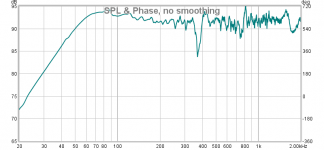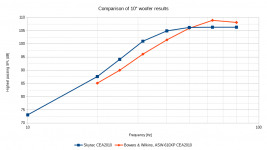Just checking this test procedure will produce comparable numbers to the correct far field procedure for sub-woofers with one output (cone, port etc.) (IE not a bass reflex where the port and cone need to combine).
What I am doing is performing a gated far field measurement of a single 10" low cost driver in a 40L sealed box and splicing it with a near field measurement. I have made the near field measurement after the far field. The near field has to be reduced in level in my case by 21.9dB to match with the far field. The dip at 370Hz in the frequency response matches the out of phase reflection from the back of the un-stuffed box.
I then start producing CEA-2010 tone bursts in REW and finding the maximum level that passes the test mask with the mic in the same position. I then take those levels and use the correction factor to get my far field CEA-2010 comparable result.
I guess this could also be done with multiple outputs using multiple microphones and summing the output after multiplication by their respective correction factors. However there is no facility in REW for this.
Attached are my results which look comparable to a similar system in Data-Bass:
Data-Bass
What I am doing is performing a gated far field measurement of a single 10" low cost driver in a 40L sealed box and splicing it with a near field measurement. I have made the near field measurement after the far field. The near field has to be reduced in level in my case by 21.9dB to match with the far field. The dip at 370Hz in the frequency response matches the out of phase reflection from the back of the un-stuffed box.
I then start producing CEA-2010 tone bursts in REW and finding the maximum level that passes the test mask with the mic in the same position. I then take those levels and use the correction factor to get my far field CEA-2010 comparable result.
I guess this could also be done with multiple outputs using multiple microphones and summing the output after multiplication by their respective correction factors. However there is no facility in REW for this.
Attached are my results which look comparable to a similar system in Data-Bass:
Data-Bass
Attachments
Can you clarify whether the sub was measured outdoors in a ground plane environment for the far-field measurement? What mic distance? How far away from structures and large objects?
Was the nearfield measurement conducted indoors?
One issue with extreme nearfield measurements is the overall response shape is slightly different than anechoic or outdoor half space. Unless the nearfield measurement is extremely close room effects can influence the measurement. Small changes in distance with a close mic can result in large changes in observed SPL at the mic. Headroom in the mic preamp and capsule is another issue with nearfield measurements.
Distortion is greatly affected by room or boundary acoustics. In general it is usually lowered dramatically in the deep bass when compared to an outdoor measurement. When distortion is set as a threshold for a pass or fail result this is problematic.
As far as developing a generic nearfield cal file to normalize to outdoor measurements it would work in a general sense to get into the ballpark and acquire data on a personal design or for ones own comparable data but shouldn't be compared with other data sets captured in other ways. There are too many added variables for that. This type of thing works well for response shape and general trends but not as well for things like CEA-2010.
Was the nearfield measurement conducted indoors?
One issue with extreme nearfield measurements is the overall response shape is slightly different than anechoic or outdoor half space. Unless the nearfield measurement is extremely close room effects can influence the measurement. Small changes in distance with a close mic can result in large changes in observed SPL at the mic. Headroom in the mic preamp and capsule is another issue with nearfield measurements.
Distortion is greatly affected by room or boundary acoustics. In general it is usually lowered dramatically in the deep bass when compared to an outdoor measurement. When distortion is set as a threshold for a pass or fail result this is problematic.
As far as developing a generic nearfield cal file to normalize to outdoor measurements it would work in a general sense to get into the ballpark and acquire data on a personal design or for ones own comparable data but shouldn't be compared with other data sets captured in other ways. There are too many added variables for that. This type of thing works well for response shape and general trends but not as well for things like CEA-2010.
The sub was measured indoors using a time gated measurement to get a quasi anechoic response. This was then spliced with a non time gated measurement with the microphone almost touching the dust cap to get the low frequencies. The distortion testing was done without moving the microphone.
I have a UMIK-1 that gets 1% THD @ 133dB spl which I kept below for all tests even including the (fixed dB offset) compensation I applied.
The idea is not to create a generic cal file but to be able to get representative measurements for my specific circumstance of sealed subs as I want to see how they compare to systems in the data-bass.
I have a UMIK-1 that gets 1% THD @ 133dB spl which I kept below for all tests even including the (fixed dB offset) compensation I applied.
The idea is not to create a generic cal file but to be able to get representative measurements for my specific circumstance of sealed subs as I want to see how they compare to systems in the data-bass.
Last edited:
Nice effort kipman725 !
The few times I've run CEA-2010, I've followed this Manual CEA-2010 Measurement Manual
along with paying great attention to the procedural info that Josh gives on data-bass
FWIW, I can't imagine running CEA anywhere but outdoors.
I see in the linked manual that a room correction factor is allowed, but it's a complicated process, that leaves room for a lot of slop IMO.
And really, I don't trust any indoor sub measurements, no matter how carefully we gate and splice. I've never made any indoor sub measurements that hold up well to outdoor reflection free tests.
Plus I think we really do have to get a couple of meters away for valid measurements...
The few times I've run CEA-2010, I've followed this Manual CEA-2010 Measurement Manual
along with paying great attention to the procedural info that Josh gives on data-bass
FWIW, I can't imagine running CEA anywhere but outdoors.
I see in the linked manual that a room correction factor is allowed, but it's a complicated process, that leaves room for a lot of slop IMO.
And really, I don't trust any indoor sub measurements, no matter how carefully we gate and splice. I've never made any indoor sub measurements that hold up well to outdoor reflection free tests.
Plus I think we really do have to get a couple of meters away for valid measurements...
Nice effort kipman725 !
The few times I've run CEA-2010, I've followed this Manual CEA-2010 Measurement Manual
along with paying great attention to the procedural info that Josh gives on data-bass
FWIW, I can't imagine running CEA anywhere but outdoors.
I see in the linked manual that a room correction factor is allowed, but it's a complicated process, that leaves room for a lot of slop IMO.
And really, I don't trust any indoor sub measurements, no matter how carefully we gate and splice. I've never made any indoor sub measurements that hold up well to outdoor reflection free tests.
Plus I think we really do have to get a couple of meters away for valid measurements...
how is everyone managing to find outdoor locations to do sub measurements? just large gardens? anywhere I can think of has no electrical power.
- Status
- This old topic is closed. If you want to reopen this topic, contact a moderator using the "Report Post" button.
- Home
- Loudspeakers
- Subwoofers
- CEA-2010 nearfield?

